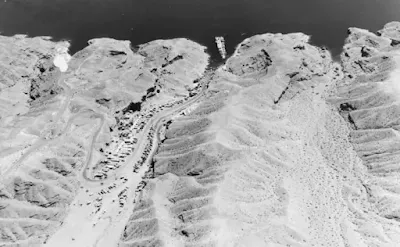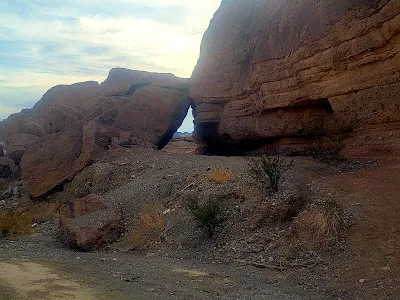“I remember coming here fishing as a young man in the early seventies,” the now older man said. “It was a wonderful location for families to camp, boat, and just have fun.”
Laureen, my lovely wife, and I had just met this fella along the shores of the Colorado River, not far south of the Hoover Dam.
 |
| South side of Hoover Dam |
In all transparency, we were actually at Lake Mohave, but it is still all part of the Colorado River. In fact, gold ore used to be shipped along the river near the town of Nelson 350 miles to the Gulf of California. With the building of Hoover Dam, Davis Dam and others, the river was tamed and man-made lakes were created, but it is still all part of the Colorado River system.
We had been out exploring places we had not yet visited when we had found ourselves along the shore of crystal clear waters.
“Then in an instant it was all gone,” he concluded, and then drove off through the sandy wash westward.
 |
| All that is left of the once popular Nelson Landing |
A sobering moment as we learned we were standing on the ground where Nelson’s Landing had once stood. A river resort that had been loved and shared by countless folks for decades.
Nelson’s Landing had been located on the western edge of Lake Mohave in El Dorado Canyon, roughly five miles east of the ghost town of Nelson - which is where Laureen and I had actually been heading. But, unbeknownst to us - there was another story at the end of the pavement when we had decided to travel past the ghost town.
“Let’s see if we can get to the river on this road before touring Nelson,” Laureen had said, and being the dutiful husband and traveler agreed.
“All roads lead somewhere interesting,” I replied.
At that moment the idea of interest had been an understatement. Turned out to be a black ribbon of asphalt that had a tale of horror and tragedy at the end of it.
Nelson’s Landing had been a small beach settlement enjoyed by locals and visitors alike. Mobile homes, RVs, campsites, boat docks, restaurants, and other amenities made this place a must go river spot.
 |
| Original photo of what Nelson Landing looked like before the tragedy |
Looking for a choice for water activities, there is Lake Mead, north of Hoover Dam or Lake Mohave, south of Hoover Dam. Take your pick. Either would be a good choice on a hot day. It was an easy destination for people living in nearby Boulder City or even Las Vegas, a mere 50 miles away.
One such summer day was September 14th, 1974 where people were boating, laying on the sandy beach, camping, and enjoying lunch in one of the restaurants at the landing when the unexpected reared its ugly head.
Miles away to the west a storm cloud showed up and poured a monsoonal amount of rain onto the dry desert soil in only a few minutes.
The torrent splattered the desert floor, but with the sun scorched hardened earth the ground was like a piece of tile and that rain simply did what gravity intended - flow downhill undeterred.
 |
| Narrow canyon walls allowed torrents of water to flow |
Soon a forty foot wave of water channeled from five separate smaller canyons rushed through El Dorado Canyon toward the resort. In a matter of minutes the resort was completely wiped out.
Among the rubble, only memories were left by those who had survived.
Nine people died on that fateful day.
 |
| Rescue workers looking for survivors at Nelson Landing |
According to a July 9, 2019 online news article from 8@NewsNow.com (Las Vegas) - local resident, Tony Werly stated: “That’s fifty-two square miles that all merged into that one canyon. As the cloud was coming down the mountain, they (the people who had been enjoying the day at Nelson Landing) were trying to get their boat docks out of the water before they got rained on. They never knew what was coming down the canyon with it.”
Werly also stated a teacher he had once had, Jack Dailey, had been one of the victims of the flooding disaster.
“Dailey was actually a school teacher of mine when I was in high school and he was one of the guys that died.”
Dailey’s friend, John Gellifent, was also interviewed.
“Jack was out boating,” Gellifent said. “He was coming back when the wall of water hit.”
Turns out the teacher and friend of Gellifent’s had been out enjoying the river and upon returning to the beach in his boat he was overtaken by the destructive path of the flood and killed just offshore.
Nelson’s Landing was never rebuilt. There are now signs warning visitors that the chance of a severe flood is a real and present danger.
We looked out across the area where one minute visitors were having the time of their lives and the next, there was no time left.
“How horrible,” Laureen said. “To be here with your family enjoying a wonderful day and then that happens.”
I did not reply. My gaze took in the blue waters of the river in front of me and I could almost hear the terrified screams of those watching from wherever they were at the moment as a tsunami barreled down on them.
And then the frantic search and rescue through the rubble that had been a popular beach resort must have been heart wrenching.
It did not take a vivid imagination to feel what those poor folks felt as they looked westward up El Dorado Canyon and saw nothing but a huge debris filled wave of water racing toward them.
I felt chills run down my spine. To be standing at a gorgeous location, as this place is, and then to realize you are standing on hallowed ground.
People had perished here. Their only fault, just enjoying a hot summer day by cool waters.
It was not something we had expected to experience as we had happily been driving north along US Route 93 toward Boulder City, Nevada when we took a short jaunt toward the ghost town of Nelson.
A few years ago, my buddy Paul and I had powered up the Colorado River from Katherine Landing aboard my pontoon boat. It was a casual camping excursion, where we took in gorgeous inlets, water canyons, hidden coves, witnessed families of Bighorn sheep, and wild donkeys. The final destination of cruising by Willow Beach, on the Arizona shore to the Hoover Dam 12 miles to the northwest.
 |
| The blue waters of Lake Mohave |
The previous day, we had witnessed dozens of people laughing while they jumped from some pretty high natural cliffs alongside the Colorado River on the Nevada Shore.
All through the warm months, people flock to Nelson’s Landing to jump off the cliffs into Lake Mohave. Some spots along the steep walls are 50 feet high and caution as well as a little dose of common sense are needed here.
I wondered if those summer loving folks realized that less than half a century ago, folks had literally fought for their lives on that sunny September day, and some had fought in vain.
“I boated past this spot without realizing the tragedy which had taken place,” I said to Laureen. “When Paul and I made our way to the Hoover Dam and saw people jumping into the water. Never thought of where or how tragic this place was.”
Laureen nodded.
Though the temperature was in the high thirties when we visited in January, the sun was shining making the water sparkle and the sand crunch beneath our feet.
No sign of a past calamity was to be witnessed in this picturesque setting. Just quiet and beautiful.
According to the National Weather Service - ‘Flash floods can roll boulders, tear out trees, destroy buildings and bridges, and scour out new channels. Rapidly rising water can reach heights of 30 feet or more. Furthermore, flash flood-producing rains can also trigger catastrophic mudslides. You will not always have a warning that these deadly, sudden floods are coming. Most flood deaths are due to FLASH FLOODS.’
 |
| The strength of rushing waters can dislodge huge section of earth |
The fun-loving people enjoying a hot September day in 1974 did not think twice about a dark cloud far away on the horizon - why should they? But, in a matter of a blink of an eye rain fell in huge amounts and turned that care-free event into a horrific and unforgettable catastrophe.
The teacher, Jack Dailey, did not live to see a school named after him in Las Vegas - Dailey Elementary School.
Though I often make light of being out in nature and possibly ignoring signs about this or that - driving out of El Dorado Canyon on that January morning reminded me that signs are there for a reason and must be taken seriously.















